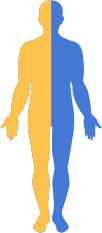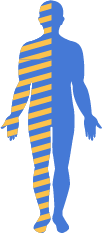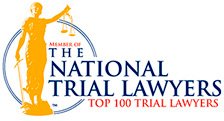Unilateral Cerebral Palsy
Unilateral Cerebral Palsy, which includes hemiplegia and hemiparesis, is a condition that affects muscle control and function on one side of the body. If unilateral Cerebral Palsy results from damage to the left side of the brain, the right side of the body will be affected, and vice-versa. It is a fairly common form of Cerebral Palsy, accounting for upwards of a third of all cases.
- Weakness, stiffness, and muscular rigidity on one side of the body – especially in the upper part of the body
- Problems with walking
- Difficulties with balance
- Keeping one hand balled into a fist
- Favoring one hand before age 3
- Trouble writing or performing tasks that require fine motor skills
- Developmental delays
Other related conditions that are common among patients with unilateral Cerebral Palsy include:
There are a number of other conditions that could cause hemiplegia or hemiparesis as well. A few examples include:
- Injury during labor and delivery
- Head trauma
- Stroke
- Hemorrhage
- Brain tumor
- Hereditary conditions
- Hydrocephalus
- Meningitis, encephalitis and other infections.
It is important to realize that unilateral Cerebral Palsy is not a progressive condition – the underlying condition does not get worse over time. However, some symptoms may undergo changes depending on the child’s development, environment and therapy.
At the same time, there is no known cure for unilateral Cerebral Palsy. There are, however, treatments that can help children with the condition reach their full potential.
Hemiplegia is paralysis of one half of the body – either the left side or the right side, depending on where the brain damage occurred. Hemiparesis involves weakness that is less extensive than paralysis on either the left half or the right half of the body.


Some potential treatments for unilateral Cerebral Palsy include:
 Physical therapy, including stretching, strengthening and the use of braces
Physical therapy, including stretching, strengthening and the use of braces Occupational therapy to help the child perform the tasks of daily living
Occupational therapy to help the child perform the tasks of daily living Speech therapy
Speech therapy Behavioral therapy and counseling
Behavioral therapy and counseling Medication
Medication Surgery
SurgerySince every case of unilateral Cerebral Palsy is unique – as is every patient, the particular course of treatment will vary. The degree of success of any particular treatment also depends to a large degree on the individual characteristics of the condition and the child.
- Pyramidal or spastic Cerebral Palsy
- Spastic diplegia/diparesis
- Spastic quadriplegia/quadriparesis
- Extrapyramidal or non-spastic Cerebral Palsy
- Ataxic Cerebral Palsy
- Dyskinetic Cerebral Palsy
- Dystonic Cerebral Palsy
- Chorea
- Choreoathetoid
- Dystonia
- Ataxic Cerebral Palsy
- Mixed Cerebral Palsy
- Athetoid Cerebral Palsy (Dyskinetic Cerebral Palsy)
MyChild™ offers free case evaluations and answers to your questions about your child’s unilateral CP. Fill out our online contact form now for confidential and caring assistance.







